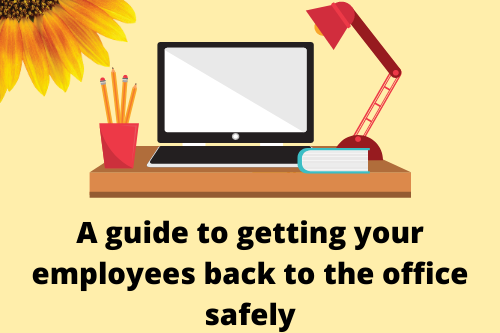A guide to getting your employees back to the office safely
Posted on 6th July 2020
From our recent conversations with our business community, it’s clear that the biggest concern right now is getting your team back to work safely. Your team are probably working safely from home and have been since lockdown, however now, it’s about helping to shift their mindsets to wanting to come back to the office. Many employees are questioning the purpose of an office space as there are reports of not only equal productivity working from home, but in some cases, increased productivity, so why get people back to the office at all?
- Resounding results from employees is that they want a hybrid approach, ideally 50/50 split.
- There are people who just can’t work from home for various reasons
- Humans are social animals; we need to interact!
So, what is there to think about?
Offices will no longer be the primary place of work in the main, however getting the mindsets of employees to feel as safe in the office as at home is going to the be the biggest challenge for employers.
As mental wellbeing is at the top of all people leaders lists, getting the ‘back to work’ process successfully delivered is going to be the difference in success and failure in your organisation. After all the work you’ve done to furlough, retain and support your people, the last thing you want to do is lose great talent because they don’t feel safe whilst you ease out of lockdown. Our top tips for getting your workforce back to the office safely are as follows:
1. One size does not fit all. Start with a survey to understand who does and doesn’t want to go back to the office. Think about who should be on site, and how many should be on site, and where possible, try to work within your employees’ preferences. You can always change and adapt this, but it’s a good way to test the water, and help to make your team feel comfortable.
2. Speak to your landlord, or your contact for your shared office space, and find out what they are doing to keep your people safe in the common areas of your building. If you’re not happy with their plan, push back.
3. The public transport bottle neck. It’s been shown that one of the biggest concerns with returning to work is public transport. 75% of employers cite this as their biggest challenge in getting their team back to the office. Where possible, encourage your staff to walk/cycle, and where not possible, stagger the commute to minimise exposure. Trains and buses are preferable over the tube.
4. Timetable everything. Ensure that you have a central port of who will be in and out of the business at any one time so that your office safety guidelines are not breached (see the Maine legal summary for more details)
5. Monitor and record! If you have visitors into your office, ensure you track and record their details, so if you do need to let them know about a possible case, you can reach out and let them know to self-isolate.
6. Within the office, the desk layout, use of meeting rooms and common places are all under scrutiny. The use of screens, back to back working and no closed door meetings are all solutions to the art of engagement in the work place post pandemic. Also try to limit hot desking as much as possible. Put up posters as reminders and install multiple sanitiser stations throughout your space. Also, keep windows open as much as possible to maximise airflow and ventilation.
7. Carry out weekly wellbeing checks with all your people to understand how they are feeling whilst easing out of lockdown. Provide personal protection boxes so that each individual feels seen, heard and supported.
8. Create a ‘post-pandemic’ policy. Publish this on your website, share it on your intranet, email to all employees and let all your stakeholders know what you’re doing as an organisation to keep everyone in your network safe. Safety and success go hand in hand here.
9. Common places will require monitoring for overcrowdedness and cleanliness, so put a plan in place. If you don’t have a facilities manager, allocate a safety officer to be responsible for this. One way routes and regular cleaning monitoring will be a part of this. Make sure you recognise them and celebrate them and thank them for the work they’re doing.
10. Reflect and review regularly! As much as it is important to have consistency and predictability, to ease the mindset of your team, it is important to acknowledge that these are unprecedented times. Most organisations will be trialling different solutions, so keep what works and review monthly.
For any further information, guidance or support on getting your team back to the office please don’t hesitate to get in touch.

